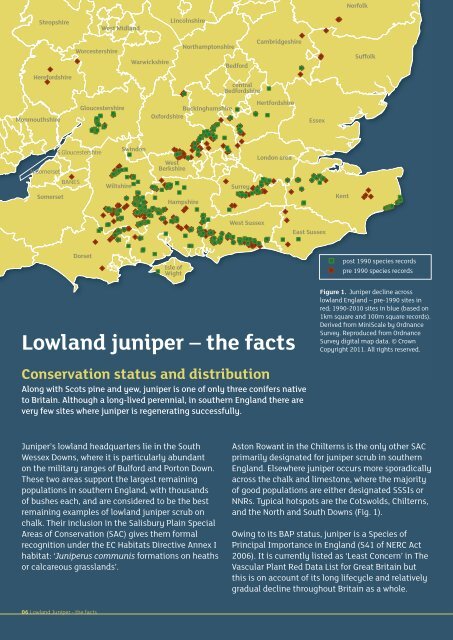Breaking new ground for juniper - Plantlife
Breaking new ground for juniper - Plantlife
Breaking new ground for juniper - Plantlife
- No tags were found...
Create successful ePaper yourself
Turn your PDF publications into a flip-book with our unique Google optimized e-Paper software.
NorfolkShropshireHere<strong>for</strong>dshireMonmouthshireWorcestershireWest MidlandGloucestershireWarwickshireLincolnshireNorthamptonshireBuckinghamshireOx<strong>for</strong>dshireBed<strong>for</strong>dcentralBed<strong>for</strong>dshireCambridgeshireHert<strong>for</strong>dshireEssexSuffolkHabitatJuniper can be found growing on a wide variety of soiltypes and topographies but in lowland England today itchiefly occurs on chalk downland or limestone grassland.The grassland communities that support <strong>juniper</strong> (Box 1)are frequently species rich themselves, containing otherthreatened plants such as wild candytuft, musk orchidand pasqueflower. These wild flowers stand to benefit fromhabitat management <strong>for</strong> <strong>juniper</strong>.S.GloucestershireN.SomersetBANESSomersetWiltshireSwindonWestBerkshireHampshireLondon areaSurreyWest SussexEast SussexKentOther typical habitats include: ancient trackways, pathsand waysides, disused quarries, cliff faces, earthworks andrarely heathland.Where scrub or young woodland have colonised, <strong>juniper</strong>will slowly die out. Ironically, its prickly foliage mayhasten woodland development by acting as a nursetree <strong>for</strong> other species – e.g. yew. At some Chilterns sites<strong>juniper</strong> has been lost under beech although this may be aconsequence of historical plantations.Pasqueflower© Photo creditDorsetIsle ofWightLowland <strong>juniper</strong> – the factsConservation status and distributionAlong with Scots pine and yew, <strong>juniper</strong> is one of only three conifers nativeto Britain. Although a long-lived perennial, in southern England there arevery few sites where <strong>juniper</strong> is regenerating successfully.post 1990 species recordspre 1990 species recordsFigure 1. Juniper decline acrosslowland England – pre-1990 sites inred; 1990-2010 sites in blue (based on1km square and 100m square records).Derived from MiniScale by OrdnanceSurvey. Reproduced from OrdnanceSurvey digital map data. © CrownCopyright 2011. All rights reserved.Box 1. Lowland plant communitiesThe National Vegetation Classification communities listed below reflect the diversity of calcareousgrassland habitat that <strong>juniper</strong> inhabits. Remarkably, only CG2 and CG7 typically feature bare <strong>ground</strong>which is considered a prerequisite <strong>for</strong> <strong>juniper</strong> seedling establishment. The other communities maythere<strong>for</strong>e be sub-optimal <strong>for</strong> recovery.Main lowland grassland communities supporting <strong>juniper</strong>:• CG2a Festuca ovina – Avenula pratensis grassland, Cirsium acaule – Asperula cynanchica subcommunity• CG2b Festuca ovina – Avenula pratensis grassland, Succisa pratensis – Leucanthemum vulgare subcommunity• CG3a Bromus erectus grassland, typical sub-community• CG3d Bromus erectus grassland, Festuca rubra – Festuca arundinacea sub-community• CG5a Bromus erectus – Brachypodium pinnatum grassland, typical sub-community• CG7 Festuca ovina – Hieracium pilosella – Thymus praecox/pulegioides grasslandJuniper’s lowland headquarters lie in the SouthWessex Downs, where it is particularly abundanton the military ranges of Bul<strong>for</strong>d and Porton Down.These two areas support the largest remainingpopulations in southern England, with thousandsof bushes each, and are considered to be the bestremaining examples of lowland <strong>juniper</strong> scrub onchalk. Their inclusion in the Salisbury Plain SpecialAreas of Conservation (SAC) gives them <strong>for</strong>malrecognition under the EC Habitats Directive Annex Ihabitat: ‘Juniperus communis <strong>for</strong>mations on heathsor calcareous grasslands’.Aston Rowant in the Chilterns is the only other SACprimarily designated <strong>for</strong> <strong>juniper</strong> scrub in southernEngland. Elsewhere <strong>juniper</strong> occurs more sporadicallyacross the chalk and limestone, where the majorityof good populations are either designated SSSIs orNNRs. Typical hotspots are the Cotswolds, Chilterns,and the North and South Downs (Fig. 1).Owing to its BAP status, <strong>juniper</strong> is a Species ofPrincipal Importance in England (S41 of NERC Act2006). It is currently listed as ‘Least Concern’ in TheVascular Plant Red Data List <strong>for</strong> Great Britain butthis is on account of its long lifecycle and relativelygradual decline throughout Britain as a whole.Wildlife dependent on <strong>juniper</strong>Juniper is almost a habitat in its own right,supporting an impressive range of wildlife, includingsome species that could not survive without it.Juniper berries and shoots provide a food source <strong>for</strong>wild birds and mammals, especially during autumnand winter months and it supports over 50 insects,such as the <strong>juniper</strong> shield bug, <strong>juniper</strong> aphid and<strong>juniper</strong> carpet moth. Juniper also provides idealhabitat <strong>for</strong> spiders. Studies show that the largerthe populations of <strong>juniper</strong>, the greater diversity ofinsect species. In addition, over 40 species of fungiare either entirely or partially dependent on <strong>juniper</strong>,and its stems and branches can support a range oflichens and bryophytes.Bare <strong>ground</strong> around <strong>juniper</strong> can attract a variety ofearly successional plants and wildlife. Species suchas kidney vetch and horseshoe vetch are importantfood plants <strong>for</strong> butterfly larvae, with the <strong>for</strong>mer thesole larval food plant of the small blue – a Speciesof Principal Importance in England (S41 of NERCAct 2006). Similarly, butterflies that require a shortsparse turf stand to gain, e.g. the Near Threatenedsilver-spotted skipper.06 Lowland Juniper - the facts<strong>Breaking</strong> <strong>new</strong> <strong>ground</strong> <strong>for</strong> lowland <strong>juniper</strong> 07
















